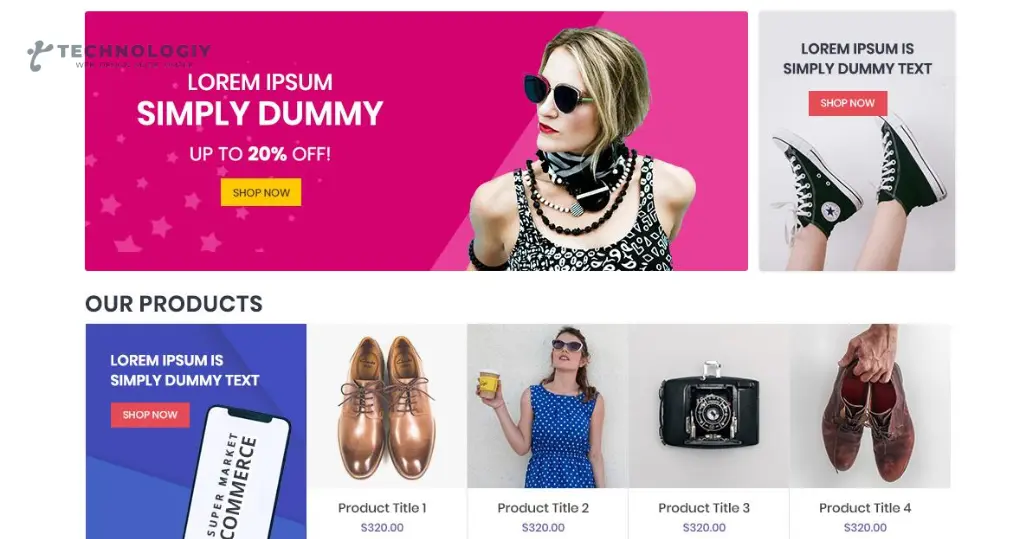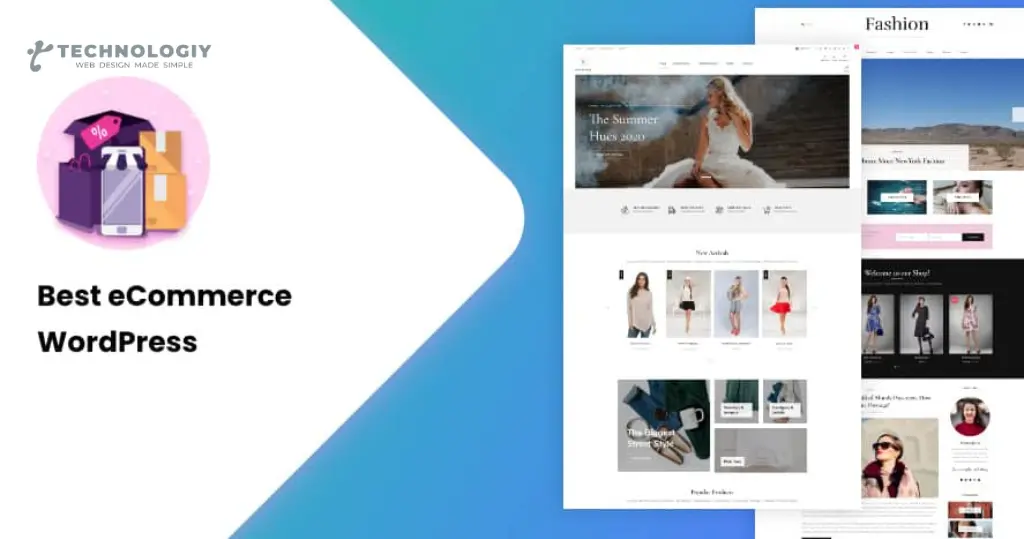In the ever-evolving world of e-commerce, having a visually appealing and user-friendly website is crucial for capturing the attention of potential customers. With the increasing popularity of WordPress as a platform, combining it with an effective e-commerce design becomes a winning formula for online success. In this blog post, we will delve into the reasons why E-commerce WordPress design matters and how it can be a game-changer for your online store’s growth.
Enhanced User Experience:
E-commerce WordPress design focuses on creating a seamless browsing experience for your customers. A well-structured and visually appealing layout ensures easy navigation, allowing visitors to find products effortlessly. By utilizing intuitive menus, search bars, and strategically placed call-to-action buttons, you can guide your customers through their shopping journey, ultimately increasing conversions and sales.
Mobile Responsiveness:
With the growing number of users accessing the internet via mobile devices, having a mobile-responsive e-commerce website is no longer an option but a necessity. E-commerce WordPress design provides responsive themes and templates that automatically adapt to different screen sizes, ensuring that your online store looks and functions flawlessly on smartphones and tablets. By catering to mobile users, you can tap into a vast market and provide a seamless shopping experience on the go.
Customizability and Flexibility:
One of the greatest advantages of E-commerce WordPress design is its flexibility and customizability. WordPress offers a wide range of themes and plugins specifically designed for e-commerce, allowing you to tailor your website to align with your brand and unique selling proposition. Whether you want to showcase your products in a grid layout, incorporate a customer review system, or integrate multiple payment gateways, WordPress provides the tools and options to bring your vision to life.
Search Engine Optimization (SEO) Friendliness:
E-commerce WordPress design inherently incorporates SEO best practices, giving your website a competitive edge in search engine rankings. WordPress offers SEO plugins that enable you to optimize your product pages, meta tags, URLs, and content structure effortlessly. By leveraging SEO-friendly features and practices, you can improve your online visibility, attract organic traffic, and increase the chances of your online store being discovered by potential customers.
Seamless Integration with Marketing Tools:
Marketing plays a crucial role in driving traffic and increasing conversions for your e-commerce store. WordPress seamlessly integrates with various marketing tools, allowing you to implement strategies such as email marketing, social media integration, and content marketing to promote your products effectively. By harnessing the power of WordPress plugins and integrations, you can amplify your marketing efforts and maximize your online store’s growth potential.
Elements of Effective Design for E-commerce WordPress Websites In the competitive world of online business, having an effective design for your e-commerce website is crucial to attract and retain customers. With the rising popularity of WordPress as a platform for e-commerce websites, it is important to understand the key elements of effective design that can make your online store stand out from the crowd. In this blog post, we will discuss the essential components of a successful e-commerce WordPress design.
User-Friendly Navigation:
A well-designed e-commerce website should have an intuitive and easy-to-use navigation menu. This ensures that visitors can easily find the products they are looking for without getting frustrated. Use clear categories and subcategories and include a search bar to simplify the browsing experience for your customers.
Responsive Design:
With the increasing use of mobile devices, it is essential to have a responsive design for your e-commerce website. This means that your website should adapt to different screen sizes and resolutions, providing an optimal viewing experience on smartphones, tablets, and desktops. Implementing a responsive design not only enhances user experience but also contributes positively to search engine rankings.
High-Quality Visuals:
In the world of e-commerce, visuals play a crucial role in attracting and engaging customers. Utilize premium product images that effectively showcase your products from various perspectives. Consider investing in professional photography or utilizing stock images to create a visually appealing website. Additionally, incorporate videos and interactive elements to enhance the overall user experience.
Clear Call-to-Action Buttons:
The ultimate goal of an e-commerce website is to convert visitors into customers. To achieve this, it is important to have clear and prominent call-to-action buttons throughout your website. Whether it’s a “Buy Now” button or a “Add to Cart” button, make sure they are visually appealing and strategically placed to encourage visitors to take action.

Streamlined Checkout Process:
A complicated and lengthy checkout process can lead to abandoned shopping carts. To improve conversion rates, ensure that your e-commerce WordPress design includes a streamlined and user-friendly checkout process. Implement features like guest checkout, multiple payment options, and progress indicators to make the checkout process as smooth as possible.
SEO-friendly Design:
Optimizing your e-commerce WordPress design for search engines is essential to drive organic traffic to your website. Use SEO-friendly URLs, meta tags, and headings to improve your website’s visibility in search engine results. Additionally, optimize your product descriptions and content with relevant keywords to attract potential customers.
Trust Signals:
Establishing trust is crucial for online businesses. Incorporate trust signals such as customer reviews, trust badges, and secure payment icons to reassure visitors that their personal and financial information is safe. Highlight any security measures you have in place, such as SSL certificates, to build trust and credibility with your audience.
Social Media Integration:
Leverage the power of social media by integrating social sharing buttons and links to your social media profiles. This allows customers to easily share your products with their friends and followers, increasing your brand’s visibility and potentially driving more traffic to your website.
Mobile Responsiveness:
The majority of online shoppers using mobile devices, it’s essential to choose a theme that is fully responsive. A mobile-friendly design ensures that your website looks great and functions properly on smartphones and tablets, providing a seamless shopping experience for your customers.
Customization Options:
To make your online store stand out from the competition, you’ll want a theme that offers plenty of customization options. Look for a theme that allows you to easily customize colors, fonts, layouts, and other design elements. This will help you create a unique and visually appealing website that aligns with your brand.
E-commerce Integration:
Since you’re building an e-commerce website, it’s crucial to choose a theme that seamlessly integrates with popular e-commerce plugins, such as WooCommerce. Make sure the theme you select is compatible with these plugins and provides specific features tailored to online stores, such as product galleries, shopping carts, and payment gateways.
Speed and Performance:
The speed of your website is a pivotal element affecting both user experience and search engine rankings. Opt for a theme that is optimized for speed and performance, ensuring fast loading times for your pages. Slow-loading websites can lead to high bounce rates and lost sales, so prioritize a theme that prioritizes performance.
SEO-Friendliness:
To attract organic traffic and improve your search engine rankings, it’s essential to choose an SEO-friendly theme. Look for themes that are optimized for SEO, including clean code, proper heading structure, and schema markup. A theme that prioritizes SEO will give your website a head start in the competitive online marketplace.
Support and Updates:
When choosing a theme for your e-commerce WordPress design, it’s important to consider the level of support provided by the theme developer. Ensure that the theme you select offers timely support, documentation, and regular updates, as this will help you address any issues and keep your website secure and up to date.
Keyword Research:
The Foundation of Successful Optimization To lay a solid foundation for your product page optimization, thorough keyword research is imperative. Identify relevant SEO keywords (or synonyms) that resonate with your target audience. Leverage tools like Google Keyword Planner or SEMrush to discover high-value keywords that align with your e-commerce business. Incorporate these keywords strategically within your product page content, including titles, headings, descriptions, and alt tags, to enhance search engine visibility.
Captivating Product Descriptions:
Persuasive and Informative Crafting compelling product descriptions is an art that can significantly impact user engagement and conversions. Focus on creating unique, persuasive, and informative content that highlights the benefits and features of your products. Use descriptive language, bullet points, and subheadings to break down information into digestible chunks. Incorporate relevant keywords naturally throughout the description, ensuring it flows seamlessly and avoids keyword stuffing.
High-Quality Visuals:
A Picture is Worth a Thousand Sales In the world of e-commerce, high-quality visuals are non-negotiable. Optimize these images by compressing their file size without compromising quality, ensuring fast-loading pages. Additionally, add alt tags to your images, describing them using relevant keywords, to improve accessibility and search engine rankings.
Customer Reviews and Ratings:
Building Trust and Credibility Integrate a customer review and rating system on your product pages to foster trust and credibility. Positive reviews serve as powerful social proof, assuring potential buyers of the quality and satisfaction associated with your products. Encourage customers to leave reviews by offering incentives or sending follow-up emails post-purchase. Display these reviews prominently on your product pages, giving potential customers the confidence to make informed buying decisions.
Clear Call-to-Action (CTA):
Guiding Users towards Conversions A well-designed CTA is crucial to driving conversions on your product pages. Ensure your CTA stands out visually, using contrasting colors and compelling copy. Incorporate action-oriented words like “Buy Now,” “Add to Cart,” or “Get Yours Today.” Place the CTA button strategically on the page, making it easily accessible and visible above the fold. Regularly test and optimize your CTAs to maximize click-through rates and increase conversions.
Mobile-Friendly Design:
Seamless Shopping on the Go With an increasing number of users shopping on mobile devices, optimizing product pages for mobile responsiveness is paramount. Ensure your WordPress e-commerce design is mobile-friendly, providing a seamless user experience across different screen sizes. Optimize loading speed by minimizing unnecessary elements and implementing responsive design principles. Conduct regular testing to ensure a smooth browsing and purchasing experience for mobile users.
Choosing the Right Themes for Your E-commerce WordPress Design When it comes to creating an online store with WordPress, one of the most important decisions you’ll make is choosing the right theme. Your chosen theme will not only determine the overall look and feel of your website but also play a crucial role in its functionality and user experience. In this blog post, we’ll explore the key factors to consider when selecting a theme for your e-commerce WordPress design.
